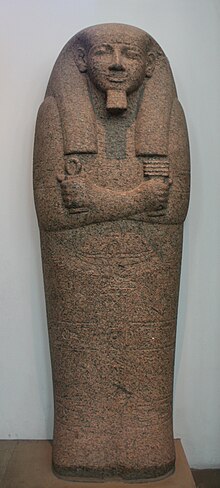| Pahemnetjer | |
|---|---|
| High Priest of Ptah in Memphis | |
 Granite sarcophagus of Pahemnetjer in the British Museum (EA 18). | |
| Predecessor | Huy |
| Dynasty | 19th Dynasty |
| Pharaoh | Ramesses II |
| Father | Mahu |
| Mother | Nena |
| Wife | Huneroy |
| Children | Didia and Prehotep II |
| Burial | Saqqara? |
| |||||
| Pahemnetjer in hieroglyphs | |||||
|---|---|---|---|---|---|
| Era: New Kingdom (1550–1069 BC) | |||||
Pahemnetjer (p3-ḥm-nṯr; "servant of the god", "priest"[1]) was a High Priest of Ptah during the reign of Ramesses II. Pahemnetjer succeeded Huy as High Priest of Ptah and was in turn succeeded by his son Didia.
Pahemnetjer was the son of a dignitary named Mahu according to a block from Florence. He was married to a lady named Huneroy, and he was the father of both Didia and Prehotep II.
Pahemnetjer held a vast array of titles: noble and count, Sole companion who is loved, the Sem-priest and Chief Directing Crafts (= High priest of Ptah), Chief of secrets in the Temples, who sees the secrets of all the gods. On his sarcophagus and inner coffin Pahemnetjer is also described as born of Geb, Ruler of Both Lands and the revered one before Thoth.[2]
The sarcophagus of Pahemnetjer is in the British Museum. The location of his tomb is not known however, but it is presumed to be in Saqqara.
Pahemnetjer is attested in/on: